GEOG 3850 midterm/final
1/187
Earn XP
Description and Tags
if studying for midterm, only go to card 109
Name | Mastery | Learn | Test | Matching | Spaced |
|---|
No study sessions yet.
188 Terms
What is the scientific method. List the steps
It is the universal recipe for examining things scientifically.
Make an observation
Ask a question
Develop hypothesis or prediction
Test the prediction
Analyze results
Record the results against the hypothesis
Make a conclusion
Peer review - either accepted and made a theory or rejected and and needs to be retested
Policy Cycle
recognition
formulation
implementation
control
What are the 7 elements of climate change?
temperature
precipitation
wind speed
wind direction
relative humidity
evaporation
solar insolation
Weather vs climate. Use conceptual model to explain
Weather is the instantaneous state of atmospheric conditions for a given place at a given time and is constantly changing. Meanwhile, climate is the average of a set of atmospheric conditions for a given region.
Climate is like a human walking a dog, which is weather. The human stays on a relatively steady path while the dog goes up and down around the human’s path.
What are climate normals?
Climate values are presented as normals averaged over a 30 year period. E.g. 1961-1990, 1971-2000, 1981-2010
What are climate anomalies? How do you find them?
Deviations from a climate normal. To find anomalies you take the observed value and subtract it from a climate normal for same unit of time for a longer or different time period.
What is climate change?
The modification of the mean or distributional characteristics of climate in a region for a specified period. This can be caused by natural and/or anthropogenic processes.
Extended periods of climate change requires a radiative imbalance between energy entering and leaving earth’s lower atmosphere
What is specific heat?
Property we can calculate for substances. Higher specific heat means it is harder to warm or cool. E.g. gold has a specific heat of 130, meaning it is easy to warm and cool, while water is 4186 making it harder to warm and cool.
What is thermal inertia?
Measure of thermal mass. responsiveness to temperature changes
What is response time?
How long it takes for a system to start responding. Differs depending on material and system
What are feedbacks?
processes initiated by an external change to a system that alters the system’s response to the initial change
What are positive feedbacks?
feedbacks that amplify an initial perturbation. E.g. the ice-albedo feedback loop: initial warming, ice melts, albedo decreases, more solar energy absorbed - Ein increases, more warming, ice melts
What are negative feedbacks?
feedbacks that diminish an initial perturbation
Fast feedbacks vs slow feedbacks
Fast: feedbacks that occur relatively quickly (days to months to years). Climate system components with fast response times
Slow: feedbacks that occur relatively slowly (years to decades to centuries). Climate system components with slow response times. Harder to observe and understand because they may occur outside human’s lives.
What are feedback factors
They measure the strength of a temperature feedback.
FF>1 = positive feedback
FF<1 = negative feedback

What is radiation? What emits it?
Energy that travels as electromagnetic waves - also referred to as electromagnetic radiation (EMR), which travels in bundles of energy called photons. Radiation can be emitted, absorbed and transmitted
Everything with a temperature emits radiation, but hotter substances emit more radiation than cooler substances.
Electromagnetic spectrum
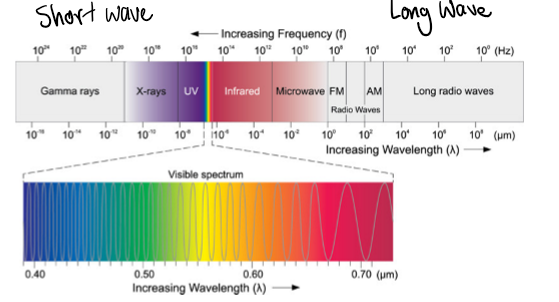
Kirchhoff’s Law
A radiation law that states that the absorptivity (a) for a substance at a given wavelength (w) is equal to its emissivity (E)
Ew = aw
What is a blackbody?
An idealized body (or planet) used in physics. It is a object or substance that emits at 100% efficiency for a given wavelength.
What is absolute zero?
Absolute zero is 0 Kelvins or -273 degrees Celsius. It is the coldest something can get
What are the three key radiation laws and what do they allow us to do?
Wien’s Displacement Law
Stefan-Boltzmann Law
Planck’s Law
These laws allow us to estimate the quantity and type of electromagnetic radiation emitted by a blackbody using just temperature
Wien’s Displacement Law
Allows you to calculate the peak wavelength of energy emitted by a blackbody using its temperature
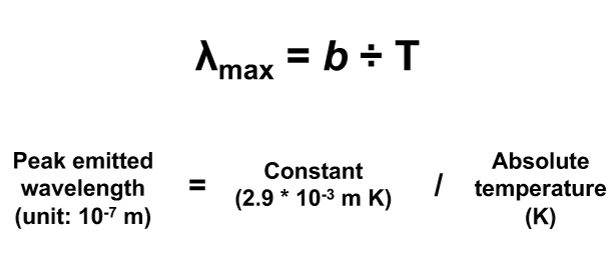
Stefan-Boltzmann Law
Allows you to calculate the total energy emitted by a blackbody using its temperature. The amount of energy radiated by an object increases with its temperature
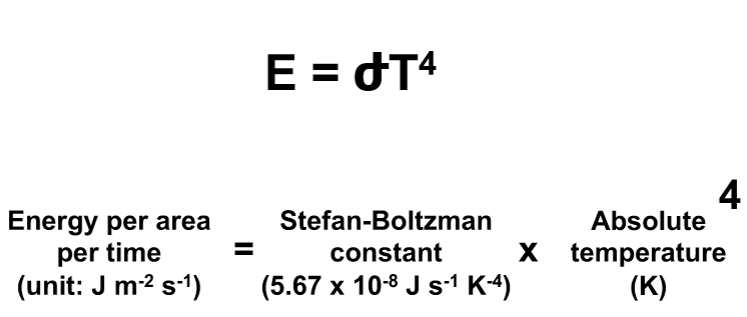
Planck’s Law
Lets us determine how much electromagnetic radiation is emitted by a blackbody for any given wavelength
Inverse Square Law
The closer an object is to something emitted it will be stronger, and the further it is from it, the emittance will be weaker.
What is the solar constant?
Earth’s total solar radiation at the top of the atmosphere (1365 W/m2)
How would we calculate the solar constant?
By using the stefan-boltzmann law to determine the total power emitted by the sun and then using the inverse square law to find distance between sun and earth. You would do this everyday to create an average, which you would then divide by 365 to find the constant.
What is the sun’s temperature and emission peak?
T = 5800K
Emission peaks from 0.15 to 3.0 - shortwave radiation
What is the earth’s temperature and emission peak?
T = 288K
Most emission is between 3.0 and 100 - longwave radiation
How much energy does the sun emit and how much does earth absorb? Why?
The sun emits 1365w/m2 (solar constant) towards earth. At earth’s surface, we only absorb 161w/m2 because of planetary factors like earth’s shape and axial tilt as well as earth’s atmosphere and surface characteristics.
Sun angle and its effects
If sun’s altitude is angle is <90 degrees (i.e. not perpendicular) , then shortwave radiation intensity will be less. This means that solar radiation (insolation) is greatest when the sun angles are vertical (concentrated), rather than oblique (dispersed).
What is earth’s axial tilt and what does this effect?
Earth is titled on its spinning axis at an angle of 23.5 degrees. This means that the poles are either tilted away or towards the sun depending on the time of year.
This effects hours of sunlight (period of daylength), angle of the sun (solar angle) and atmospheric depth (light penetration)
What poles are illuminated in summer vs winter?
In summer, the Arctic circle is illuminated, and the Antarctic circle in winter
How does the circle of illumination change as it moves around the sun
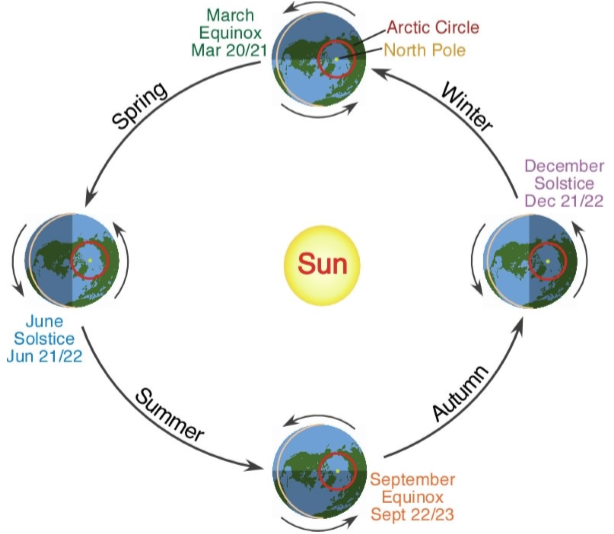
How does the shape of the earth effect incoming solar radiation?
Because it impacts the angle of the sun (solar angle) and atmospheric depth (light penetration)
How does Earth’s atmosphere impact incoming short-wave radiation?
Shortwave photons get absorbed or reflected or scattered by the atmosphere
Why is the sky blue?
Because more Rayleigh scattering occurs within the atmosphere at blue wavelengths (shortest visible wavelength)
Why does a setting/rising sun look red?
Less direct = more atmosphere to pass through = more scattering. It is red because everything but the longer red wavelength has been scattered out
Why does the sun appear yellow?
Because the shorter blue wavelengths have been scattered out
What is atmospheric scattering? What are the two types?
Reflection from an object that breaks large energy waves into smaller directional components.
Backscatter: reflecting energy off of an entity back into space
Forescatter: reflecting energy in an altered form towards original target
What is reflection?
The sun’s energy is redirected away from the particle directly back towards the sun on reverse trajectory.
How is radiation absorbed and reflected through the different layers of the atmosphere?
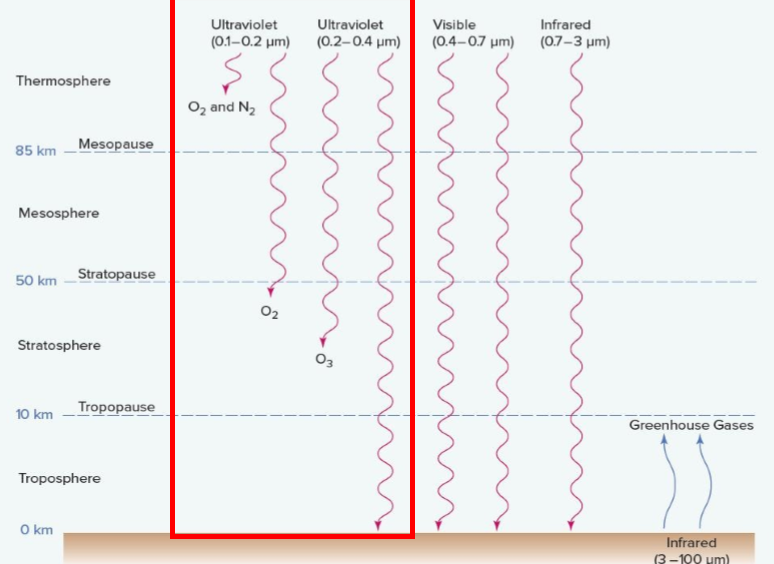
What is albedo?
Albedo indicates how well surfaces reflect solar energy. Darker surfaces have a higher rate of absorption and less reflectance, while lighter surfaces like snow absorb less and reflect more.
Longwave radiation
Wavelengths greater than 3
Longwave radiation can be re-radiated by the atmosphere via clouds and/or greenhouse gases
What are greenhouse gases?
Radiatively active gases that absorb and emit infrared spectrum (5-20) photons. These are well-mixed gases that emit in all directions.
These gases re-emit longwave radiation because they vibrate in multiple directions which makes them more likely for interactions with photons. This is because absorption and emission of infrared spectrum photons increases with more molecular vibration.
What is the greenhouse effect? What are the main contributors?
Process through which greenhouse gases in the atmosphere create a warming effect on a planet’s surface due to infrared absorption and re-emittance. Without the greenhouse effect the average temperature on earth would drop from 15 degrees C to -18.
Main contributors:
Water vapour (50%)
Clouds (25%)
Carbon dioxide (20%)
Methane, nitrous oxide, ozone, etc (5%)
What is the enhanced greenhouse effect?
The process by which the naturally occurring greenhouse effect is increased/modified through the natural and/or anthropogenic emissions to the atmosphere. It is the key mechanism for anthropogenic global warming/climate change
What is effective radiating temperature?
The temperature at which a system radiates away as much energy as it receives. For example, for a black body this means solar radiation absorbed = terrestrial radiation emitted.
This balance is maintained by negative feedback preventing Earth’s temperature from continually rising or falling
Earth’s energy balance
Energy in conserved
energy input - energy output = change in storage
Earth’s climate
energy input radiation is absorbed
Energy output in emitted
Storage of energy determines the tempertayre
changes in energy storage drive temperature changes and heat fluxes (sensible and latent)
What is radiative forcing?
A change in earth’s energy balance
Energy Balance at the Top of Atmosphere
if system is in equilibrium this equation should be balanced (Earth’s energy IN = energy OUT)
Sunlight IN (shortwave radiation) = sunlight out (shortwave radiation) + thermal infrared out (longwave radiation)
340 = 100 + 239
340 DOES NOT EQUAL TO 339 therefore, the energy is not in balance at top of atmosphere
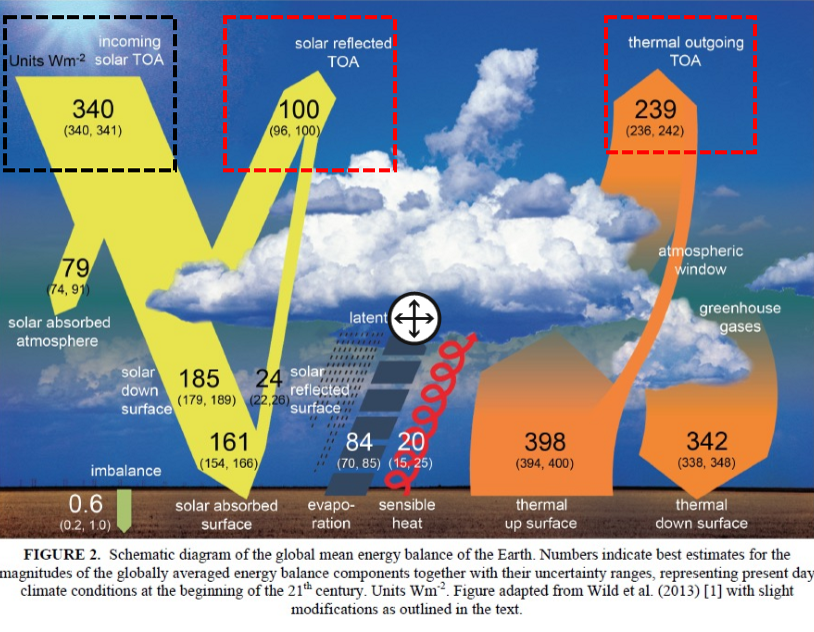
Energy balance: Atmosphere
if system is in equilibrium this equation should be balanced (atmosphere energy IN = energy OUT)
sunlight IN (shortwave radiation absorbed) + thermal infrared IN (longwave radiation absorbed) + heat fluxes IN = thermal infrared OUT (longwave radiation emitted)
79 + 398 + 84 + 20 = 239 + 342
581 = 581 in balance with the atmosphere
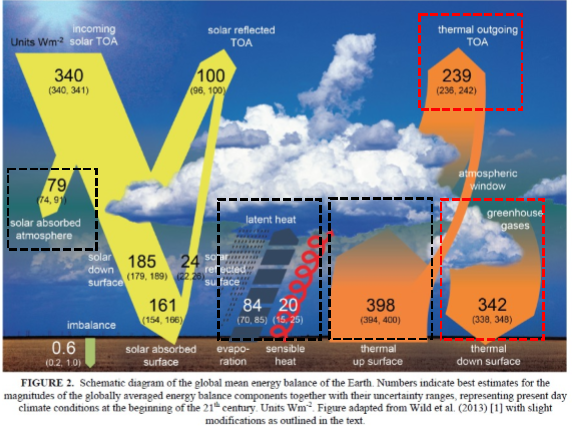
Energy balance: surface
if system is in equilibrium this equation should be balanced (surface energy IN = energy OUT)
Sunlight IN (shortwave radiation absorbed) + thermal infrared IN (longwave radiation absorbed) = thermal infrared OUT (longwave radiation emitted) + heat fluxes OUT
161 + 342 = 398 + 84 + 20
503 DOES NOT EQUAL 502 meaning energy is not in balance at surface

What is paleoclimatology? What are the primary methods?
the study of past climate that focuses on understanding the magnitude and causes of past climate change.
Primary methods:
climate reconstruction using climate proxies
Climate reconstruction and sensitivity tests using climate models
Linkages with historical geography
Historical documentation (recent period)
How old is earth? How old is the moon?
Earth 4.6 billion years old and the moon is about 30 million years younger
Relative vs absolute time
Relative - based on the principle of superposition. Older is at the base, youngest at the top
Absolute - based on radiometric dating that provides accurate age
What are the 4 types of timescales?
Tectonic: billions to millions of years
Orbital: hundreds of thousands to tens of thousands of years
Millennial: tens of thousands to hundreds of years
Historical/instrumental: period of widespread human observation of climate
What are the different types of climate proxies and the years they can date?
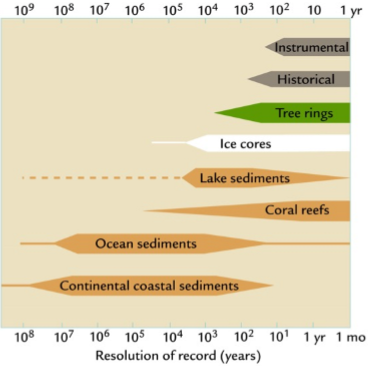
What do the fossil records of leaf size tell us?
They tell us about the environment at that time that the plant was in because the size of a leaf is tied to the plant’s ability to conduct photosynthesis. Plants in the tropics for example, get less sun in the dense forests so they have big leaves for more surface area for photosynthesis. meanwhile, in the desert they have small leaves because they get so much sunlight
Sediment cores
A type of climate proxy that relies on the law of superposition to date the layers of sediment. Affected by sediment production and deposition. Dates tectonic to orbital
Ice cores
a type of climate proxy that relies of the law of superposition to date layers of ice. The air sealed in the ice can tell us about what was in earth’s atmosphere which we can compare to now. Measures from orbital to historical
Why are most tree ring analyses done in the northern hemisphere?
Because these trees experience greater seasonality, making it easier to differentiate the rings. They have a distinct growing season in the spring and summer, where a light colour ring grows, and then in the fall and winter, as the growth slows, the wood forms more slowly and in a darker colour.
How to interpret melt layers?
Warmer summers = more melt
What are oxygen isotopes?
Any of the oxygen atoms that have the same atomic number (number of protons) but different mass numbers (different numbers of neutrons)
How can oxygen isotopes help analysis of ice volume?
16O more readily evaporates that 18O (because 18O is heavier)
Atmospheric circulation transports the more abundant 16O to the polar regions.
if the ice sheets store more 16O there is less 16O in the ocean compared to 18O, which indicates more 16O in storage in ice (meaning colder conditions)
If there were more 18O in the ice sheets compared to 16O it would mean warmer conditions
18O is greater when warmer, less when colder
What can oxygen isotopes tell us about ocean temperature?
16O more readily evaporates that 18O (because 18O is heavier)
Warmer conditions lead to more evaporation on land and the oceans
Atmosphere can also hold more water vapor
Slightly more 16O in the system compared to 18O with warmer atmosphere/ocean
18O is less when warmer, greater when colder
Radiometric dating
Dates orbital to historical. Allows us to determine the age of certain types of rocks. This process relies on the isotopic decay rates. Each isotope decays at a consistent rate, which allows us to determine the half life. The half-life is the amount of time for one half of the isotope to decay, and when it does half the original element will be gone. By comparing the amount of parent isotopes to daughter isotopes we can determine the age because of these decay rates.
What are some types of isotopes and the ages they are useful for dating?

How is pollen used as a climate proxy?
Dates from millennial to historical. It can tell us what the climate was like and what that climate allowed to grow. When looking at it under a microscope, you can count the number of pollen which can tell us how the climate is changing. Pollen grains are also well preserved in sediment layers, even in lakes, as they have tough outer walls.
Why is pollen analysis skewed to the northern hemisphere.
Because of seasonality. Trees in the northern hemisphere undergo seasonality, so they don’t produce pollen all year round like plants in the tropics do. Additionally, when wind blows the pollen into water, these lakes freeze in winter which means there is little mixing, so it can tell us exactly what trees were pollinating in the summer.
What is the faint sun paradox? What are the best explanations for this?
In early earth, solar output was 30% less, yet there is evidence of oceans and no major glaciation. The best explanations are:
Enhanced volcanism
Increased greenhouse effect
Explain the concept of earth’s thermostat for warming and cooling.
Warming: initial change occurs, leading to a warmer climate, leading to increased temperature, precipitation and vegetation, causing increased chemical weathering, which then leads to increased CO2 removal due to this weathering, which leads to a reduction of initial warming
Cooling: initial change occurs, leading to a colder climate, leading to decreased temperature, precipitation and vegetation, causing decreased chemical weathering, which decreased COs removal from weathering, which leads to a reduction of initial cooling
How are plate tectonics connected to climate change?
Global temperatures were warmer and cooler at various tectonic timescales in earth’s history
Tectonic changes have gradually moved continents
Land surfaces in polar positions promote ice growth
Location of continents influences pathways of ocean circulation
What are polar positions?
locations of earth’s polar regions (south pole and north pole) and how these have shifted over time and how this geographic position links to periods of ice age
Impact of an impact
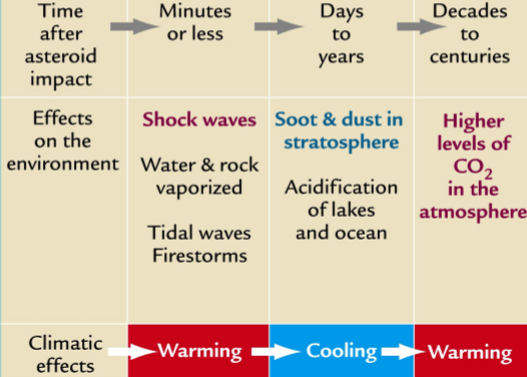
Uplift hypothesis
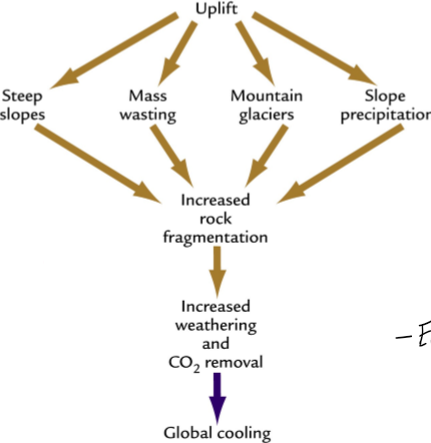
What are greenhouse periods?
Relatively warm period with no continental ice sheets. E.g. Paleocene–Eocene Thermal Maximum (PETM) 55 millions years ago
What are icehouse periods?
Relatively cold period allowing continental ice sheets. Our most recent icehouse includes glacials and interglacials
Glacials
cooler periods marked by ice expansion
Pleistocene glaciations
Last glacial maximum
Interglacial
Warmer periods marked by ice retreats like the epoch we are currently in - the Holocene/Anthropocene
What are the three types of systems?
Deterministic: process-driven system whose temporal or spatial evolution can be predicted exactly. E.g. dominos, climate systems, Milankovitch cycles
Stochastic: system where the output is governed by a probability distribution. E.g. coin flip and radioactive decay, volcanic eruption,
Chaotic: system that is associated with deterministic events that are not predictable. The outcome events occur along a bounded attractor. E.g. a pendulum
Icehouse and greenhouse eras in the last 3 million years
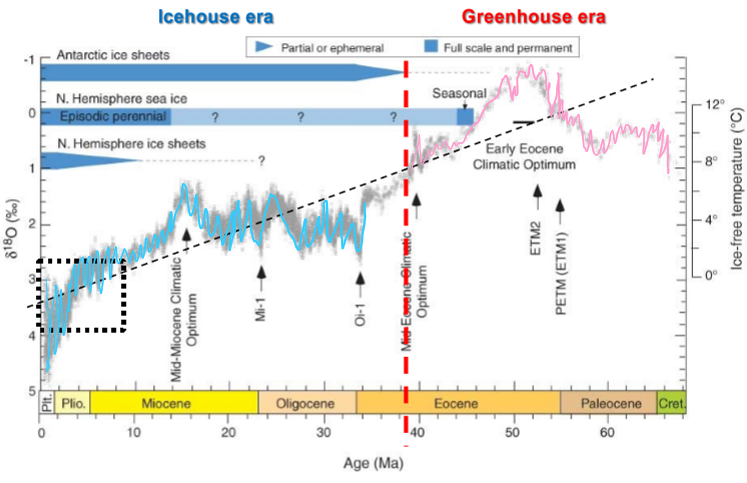
LGM
Last Glacial Maximum
Who was Milutin Milankovitch?
An astronomer/mathematician who posited that ice ages were caused by cyclical variations in solar energy received on Earth. Allowed us to develop a deterministic system
What the three variations in earth-sun geometry that Milankovitch proposed?
Eccentricity of earth’s orbit (‘elongation’)
Procession of the equinoxes (‘wobble’)
Obliquity (‘axial tilt’)
Eccentricity of the orbit (elongation)
100,000 year cycle
Orbit changes from nearly circular to elliptical
Greater eccentricity causes greater seasonality in one hemisphere and reduces it in the other
Procession of the equinoxes (wobble)
22,000 year cycle
Affects the timing of the aphelion (when earth is furthest on July 4) and perihelion (when earth is closest on Jan 3)
Winters are milder and summers cooler in northern hemisphere
Less seasonality
Winters are colder and summers warmer in the southern hemisphere
More seasonality
Obliquity (axial tilt)
41,000 year cycle
Changes tilt of axis of rotation
Varies from 22 degrees to 24.4 (currently decreasing from 23.5)
Greater tilt causes greater seasonality in both hemispheres
More tilt = more solar radiation in summer and less in winter
How do Milankovitch cycles impact glaciation?
higher insolation in northern hemisphere’s summer = ice melt
Individually though, the Milankovitch cycles are weak
Combination of cycles agrees with paleoclimate record, but the combined forcing is too small to fully explain deglaciation. Sometimes they are favorable to melt ice, but there are other feedbacks involved
What combination of earth’s variations would favor widespread ice melt in the Northern Hemisphere?
High eccentricity - one part of the year closer to the sun, greater seasonality
Perihelion occurring at summer solstice - timing of minimum distance from sun occurring at peak incoming solar radiation
High obliquity tilt - NH more tilted towards the sun on summer solstice
What drives the Milankovitch cycles?
Gravity. As planets move around, they have different orbits that we interact with differently
What climate feedbacks would have aided in deglaciation?
Ice-albedo feedback
Vegetation feedbacks
Local climate feedbacks
Emission of CO2 and other Greenhouse gases would have aided as well
How would greenhouse gases have impacted glaciation?
About 800-1000 year time lag between GHG and climate
CO2 increases via orbital warming
warmer oceans hold less CO2
changes to ocean circulation
CO2 has global temp impact

What were the three main components that drove orbital-scale climate change?
Milankovitch cycles (eccentricity, obliquity, precession)
Initially effects solar insolation received at earth’s surface in northern high latitudes
50% of last deglaciation
Ice growth/melt triggers absorption/release of greenhouse gases (with lag)
Well-mixed GHGs decrease/increase magnifying cold/warm conditions across globe (positive feedback)
30% of last deglaciation
Temperature impacts and feedbacks with oceans/vegetation
20% combination of other feedbacks
The Holocene
the current interglacial (12000 BP to present)
The climate of this epoch was stable
peak (pre-industrial) global temperatures were about 7-10k years ago during the Holocene Thermal Maximum
Coldest global temperatures were about 1.5 degrees colder than present about 200 years ago during the “little ice age”
Fairly stable climate at low latitudes, larger variability at high latitudes
Overall known for its stability
When was the medieval warm period?
900 AD - 1300 AD
When was the little ice age? What contributed to this period of cooling?
1300-1850
low solar activity due to high volcanism
What are the 5 deadliest volcanic eruptions?
Mount Pelee, Caribbean 1902
Krakatoa, Indonesia 1883
Mount Tambora, Indonesia 1815
Huaynaputina, Peru 1600
Laki, Iceland 1783
What are the 3 causes for millennial-scale variability?
Variations in solar radiation
small global effect, more prominent at high latitudes
Volcanic eruptions
block incoming short wave radiation
direct cooling lasting several years
positive feedbacks can last longer (cold summer = more ice = more albedo = colder temperatures)
Variations in ocean circulation
small global effect, more prominent in high latitudes
Strength of Atlantic Meridional Overturning Circulation
Stronger = more heat pumped northwards = less ice
Circulation Patterns
product of unequal heating because of heterogeneity on earth’s surface
currents impact the weather of the world